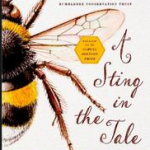Consider the bumblebee. It’s big and scary looking, it’s not supposed to be able to fly but it does, and Simon and Garfunkel called it lazy. In fact, according to Dave Goulson’s fascinating new natural history “A Sting in the Tale,” bumblebees are far from lazy. They’re important pollinators, they don’t sting often (unlike their relatives the honeybees) and, far from being lazy, they are very hard workers. They are also impressive navigators, able to find their way back to their nests from as far as 10 kilometers away.
Goulson begins with the story of the introduction of the short-haired bumblebee into New Zealand in the 1870s. British settlers had imported cattle, and clover to feed the cattle, but without bumblebees to pollinate it the clover didn’t grow well in New Zealand. The solution, obvious to the Victorian naturalists, was to import bumblebees. It took a couple of tries – in the course of which various people concerned figured out that they had to keep hibernating queen bees cool so they would survive the trip – but eventually short-haired bumblebees established themselves in New Zealand. They have thrived there ever since. Unfortunately, that’s not the case in the UK, where changing farming methods and development have largely wiped out the habitats of the short-haired bumblebee and many other species.
From this beginning, Goulson provides a two fascinating narratives: the natural history of bumblebees, with occasional forays into the lives of related insects, including honeybees and wasps, and his own life story as a biologist studying bees and their important role in the environment. He provides terrific descriptions of the evolution of the birds and the bees and their central role in the evolution of plants. That’s before he gets to the importance of bumblebees to the development of crops. Throughout, the writing is both spritely and clear:
[A]lmost every fruit or vegetable that is good to eat is pollinated by bees; imagine a diet without almonds, blueberries, raspberries, beans, apples, melons, cherries, cucumbers, pumpkins . . . Many vegetables do not require pollination by bees to produce an edible crop, but nonetheless pollination is needed to produce the seed for next year. Even cows require pollination. You may think I’m getting a bit carried away here, but many fodder crops, such as clovers and alfalfa, require bees to pollinate them . . .
Unlike other books about science, this is neither a tale of triumphs or of disasters. It’s more of a picaresque: Goulson and his students and collaborators test a theory with an experiment. Sometimes things pan out. More often, they don’t, and Goulson admits to a great many errors and failures. It’s as clear a description of the actual work of science one might hope to find. Goulson also names and credits his graduate students.
Goulson ends the tale where he began it, with the short-haired bumblebee. The Bumblebee Conservation Trust, an organization he founded, wanted to reintroduce the short-haired bumblebee to Britain. Doing so required developing sufficient habitat, which was comparatively (and surprisingly) easy, and finding suitable healthy bees. The second task was harder, as might have been expected, and Goulson describes the many useful lessons the Bumblebee Conservation Trust learned. The book, originally published in the UK last year, ends before Goulson learned whether the 2012 attempt would be successful. If you’re interested, you can get an update here.
Goulson begins with an account of his childhood fascination with insects of all kinds, and some mishaps. What’s your favorite? Let us know in the comments.
Have a book you want me to know about? Email me at asbowie@gmail.com. I also blog about metrics at asbowie.blogspot.com.
This post has been updated to correct some spellings.



